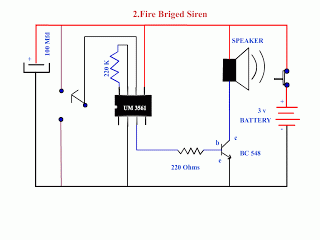
Four Tone Siren

The UM3561 features programmed mask ROM designed to simulate siren sounds. This integrated circuit operates at a low power consumption level and is powered by a 3-volt supply. An NPN transistor is utilized for the amplification of the audio signal.
The UM3561 is a versatile sound generation integrated circuit primarily used in alarm systems, toys, and other applications requiring sound effects. The programmed mask ROM contains pre-recorded sound patterns that replicate various siren tones, making it suitable for emergency alert systems.
Operating at a supply voltage of 3 volts, the UM3561 is designed to minimize power consumption, which is essential for battery-operated devices. The low power requirement allows for extended operational life in portable applications.
Audio output from the UM3561 is enhanced through the use of an NPN transistor configured as an amplifier. This transistor amplifies the audio signal generated by the IC, ensuring that the sound produced is loud enough to be effective in alarming situations. The choice of an NPN transistor is typical for such applications, as it provides sufficient gain and can drive small speakers or piezoelectric buzzers directly.
In practical applications, the UM3561 can be connected to a simple circuit consisting of a power source, the UM3561 IC, and the NPN transistor. Additional components may include resistors for biasing the transistor and capacitors for filtering purposes. The circuit design is straightforward, making it accessible for hobbyists and professionals alike.
Overall, the UM3561 is an efficient solution for generating siren sounds, combining low power operation with effective audio amplification capabilities.The UM3561 contains programmed mask ROM to simulate siren sound. Power consumption of IC is low. It is powered by 3 Volt. One NPN Transistor is used for amplification of audio signal. 🔗 External reference
The UM3561 is a versatile sound generation integrated circuit primarily used in alarm systems, toys, and other applications requiring sound effects. The programmed mask ROM contains pre-recorded sound patterns that replicate various siren tones, making it suitable for emergency alert systems.
Operating at a supply voltage of 3 volts, the UM3561 is designed to minimize power consumption, which is essential for battery-operated devices. The low power requirement allows for extended operational life in portable applications.
Audio output from the UM3561 is enhanced through the use of an NPN transistor configured as an amplifier. This transistor amplifies the audio signal generated by the IC, ensuring that the sound produced is loud enough to be effective in alarming situations. The choice of an NPN transistor is typical for such applications, as it provides sufficient gain and can drive small speakers or piezoelectric buzzers directly.
In practical applications, the UM3561 can be connected to a simple circuit consisting of a power source, the UM3561 IC, and the NPN transistor. Additional components may include resistors for biasing the transistor and capacitors for filtering purposes. The circuit design is straightforward, making it accessible for hobbyists and professionals alike.
Overall, the UM3561 is an efficient solution for generating siren sounds, combining low power operation with effective audio amplification capabilities.The UM3561 contains programmed mask ROM to simulate siren sound. Power consumption of IC is low. It is powered by 3 Volt. One NPN Transistor is used for amplification of audio signal. 🔗 External reference





